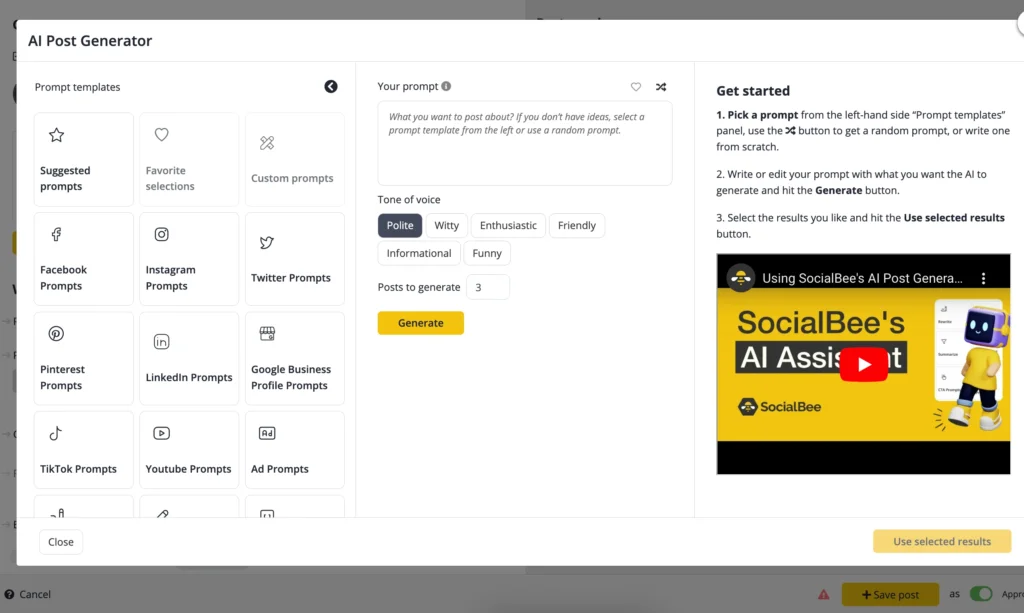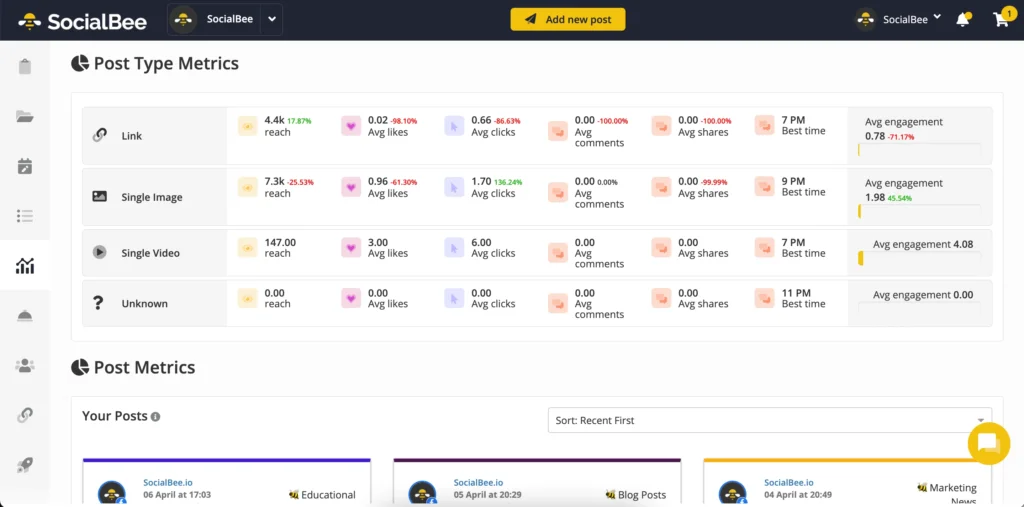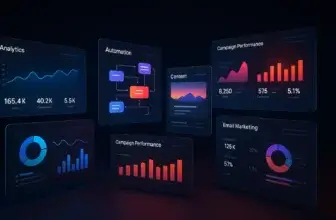Introduction
Social media management takes time. You want to post regularly, tailor each message to the network and still respond to comments without spending your day glued to a screen. That is why social media management platforms exist. Among the many tools available, SocialBee has built a reputation for making social scheduling efficient through a combination of category‑based queues, AI assistance and multi‑platform posting. This review looks at what SocialBee offers in 2025, who it is for and how it compares to other social media management tools. You’ll learn about key features, pricing, user experience, pros and cons, best practices and alternatives so you can decide if SocialBee fits your workflow.
Key Features
SocialBee’s Software Specification
SocialBee’s feature set has evolved beyond simple scheduling. Below is a detailed overview of what the platform can do.
Content categories & evergreen scheduling
Organizing your social posts into content categories is SocialBee’s signature feature. Categories let you group posts around themes, such as promotional updates, curated articles, or motivational quotes, and assign schedules independently of each other. You can choose to place new posts at the top or bottom of a queue and enable requeueing so evergreen posts repeat automatically. An integrated calendar shows all posts across categories and profiles, allowing you to plan months of content in advance and maintain a balanced mix without micromanaging every update.
Post variations & customization per platform
Every network has different character limits, media ratios, and best practices. SocialBee lets you customize each post for every platform from the same screen. You can create unlimited post variations to A/B test messages and keep evergreen content fresh with alternating captions, images, or video thumbnails. Built‑in AI can suggest captions, generate hashtags, and even recommend posting times. Tailoring content this way improves engagement and makes each post feel native to its platform.
Calendar, queue & content recycling
Scheduling in SocialBee revolves around a category‑based queue rather than a single global queue. Each category has its own posting slots, and the platform automatically picks the next post in line. You can pause a category to temporarily stop certain content types or set an expiry date so posts do not reappear after a specific campaign ends. SocialBee’s Recycle feature allows your top‑performing evergreen posts to automatically requeue for future posting. You can also schedule one‑off posts at specific times for announcements or timely content.
Integrations & connectivity
SocialBee integrates with a long list of services to streamline your workflow:
- Visual creation: Canva, Unsplash, and GIPHY integrations let you design graphics, find stock images, or add GIFs without leaving SocialBee.
- Content curation: Connect RSS feeds and import articles in bulk, or use extensions for Pocket, Quuu, and browser bookmarklets to capture share‑worthy content.
- Automation: Zapier, Pabbly, and Make (formerly Integromat) automate tasks such as adding new blog posts to your queue or notifying Slack when posts publish.
- URL management: SocialBee works with multiple URL shorteners and lets you add UTM parameters for detailed tracking.
Analytics & reporting
Understanding what works is critical for improving your strategy. SocialBee offers analytics dashboards that track audience growth, engagement rate, and top‑performing posts for each connected profile. You can view metrics such as follower growth over time, likes and comments on posts, and which categories perform best. Reports can be exported to PDF for clients or stakeholders. UTM parameters on links allow you to monitor click‑through rates and attribution. While the analytics are not as deep as enterprise tools, they provide enough insight for small businesses and agencies to refine their content.
Engage / social interaction tools
Engaging with followers matters as much as publishing. SocialBee’s Engage module consolidates comments, mentions, and direct messages from networks like Facebook, X, Instagram, and LinkedIn into organized streams. You can reply to comments, assign conversations to team members, and add internal notes. The social inbox is still basic compared to specialized social listening tools. There is no sentiment analysis or trend alerts, but it offers a convenient way to respond without opening each network individually.
AI features & Copilot
One area where SocialBee has innovated is AI assistance. The AI Copilot can generate complete social media strategies by asking you about your industry and audience, then producing suggestions for content categories, post themes, and publishing schedules. Built‑in AI writing tools generate captions, repurpose blog posts, and even suggest hashtags. For busy marketers, this AI support reduces the blank‑page problem and helps maintain a consistent tone across posts.

Pros and Cons
Benefits and Limitations of Using SocialBee
Positive
✅ Sophisticated scheduling
✅ Evergreen content focus
✅ Ease of organization
✅ Powerful integrations
Negative
❌ Limited social listening
❌ Analytics depth
❌ Learning curve
❌ Mobile app limitations
✅Pros
- Sophisticated scheduling: SocialBee’s category‑based system allows you to manage evergreen queues, schedule one‑off posts, and requeue content effortlessly.
- Evergreen content focus: Automated recycling ensures that your best posts continue to perform without extra effort.
- Ease of organization: Categories, bulk editing, and filters help you stay organized even with large volumes of content.
- Powerful integrations: Canva, Unsplash, GIPHY, and Zapier integrations streamline content creation and automation.
- AI assistance: The AI Copilot and caption generator accelerate strategy planning and content creation.
- Cost‑effective: Pricing is competitive compared to feature‑rich competitors and includes a free trial.
- Broad platform support: Direct publishing to Facebook, Instagram, X (Twitter), LinkedIn, Pinterest, TikTok, YouTube, Google Business Profile, Threads, and Bluesky.
- Growing engagement tools: The Engage module centralizes comments and messages for faster responses.
❌Cons
- Limited social listening: SocialBee does not provide advanced social listening or brand monitoring; the Engage tool is basic.
- Analytics depth: Reporting offers high‑level metrics but lacks granular insights found in enterprise tools.
- Learning curve: With many features and settings, beginners may need time to learn how categories and queues work.
- Mobile app limitations: The mobile app has limited functionality and poor user reviews.
- Calendar limitations: The calendar view does not support drag‑and‑drop rescheduling.
User Experience
User Interface and Experience
Onboarding & learning curve
Signing up is straightforward: you create an account and connect your social profiles. The platform offers a guided setup to create content categories and schedule your first posts. According to reviewers, the interface is intuitive but can feel overwhelming at first due to the many features. SocialBee’s help documentation, webinars, and community support make the learning curve manageable.
Interface, navigation & workspaces
The UI revolves around a left‑hand sidebar with sections for Dashboard, Content, Copilot, Schedule Setup, Next Posts, Analytics, Engage, and Help. Within each section, some submenus let you create posts, manage categories, or view analytics. Workspaces allow you to separate clients or brands; each workspace has its own profiles, categories, and schedules. You can invite team members, assign roles, and use approval workflows to ensure posts meet quality standards before publishing.
Mobile app / on‑the‑go use
SocialBee has iOS and Android apps that support content creation, scheduling, and basic analytics. The Google Play listing describes features such as posting across multiple networks, AI post generation, and category organization. Reviews note that the mobile app currently has limited functionality and a low rating; some users find it cumbersome for managing schedules on the go and recommend using the web version whenever possible. It is useful for universal posting reminders and quick edits, but should not replace the desktop experience.
Support & customer service
Customer reviews frequently praise SocialBee’s support team. The company offers email and live chat support, weekly webinars, and a robust help center. There is also an onboarding call for new customers. SocialBee’s community is active on Facebook, and there are frequent product updates. According to testimonials, the support team feels like family and responds quickly.

Pricing and Plans
How Much Does SocialBee Cost?
SocialBee offers three main subscription tiers with discounts for annual billing. All plans include a 14‑day free trial and a 30‑day money‑back guarantee. Here is a simplified overview:
| Plan | Price (monthly) | Social Profiles | Users | Content Categories |
| Bootstrap | $29/month or $290/year | Up to 5 | 1 user, 1 workspace | 10 categories, 1 000 posts per category |
| Accelerate | $49/month or $490/year | Up to 10 | 1 user, 1 workspace | 50 categories, 5 000 posts per category |
| Pro | $99/month or $990/year | Up to 25 | 3 users, 5 workspaces | Unlimited categories, 5 000 posts per category |
The Bootstrap plan suits solopreneurs and small teams who manage a handful of profiles. Accelerate is designed for growing businesses, adding more profiles and longer analytics history (up to two years of data). Pro is aimed at agencies and larger teams, supporting multiple workspaces and users. If you need additional social profiles, users, or workspaces, you can purchase add‑ons: extra users and workspaces cost $10/month each, and a bundle of five extra profiles costs $15/month.
Concierge services & add‑ons
Beyond the software, SocialBee offers ConciergeBee services, which pair you with certified marketing specialists to handle content creation, community management, lead generation, and more. These services are optional but can be useful if you lack the time or expertise to produce consistent content. Packages include social media specialists, video‑focused services, Instagram community management, LinkedIn lead generation, and copywriting. Pricing for these services ranges from around $129 per month for simple social media management to upwards of $1 999 per month for full content machine services.
Value compared to competitors
SocialBee positions itself as a cost‑effective yet feature‑rich scheduler. For example, Buffer’s free plan offers basic scheduling but lacks categories and automation; paid Buffer plans start at roughly $6/month per social channel and quickly become expensive when you add multiple profiles. Hootsuite and Sprout Social provide comprehensive social listening and customer support features, but cost significantly more (often starting above $99/month) and can feel bloated for users primarily interested in publishing. SocialBee’s pricing sits between these extremes: it offers robust scheduling, AI tools, and limited engagement features without the premium price tag.
Use Cases & Suitable Users
Who Should Use SocialBee
For solopreneurs & small business owners
If you manage a handful of social profiles and need a simple way to keep content flowing, SocialBee’s Bootstrap plan may be ideal. Categories help you maintain a balanced mix of promotional posts, curated articles, and evergreen content, while AI tools generate captions and hashtags. The price is reasonable, and the 14‑day trial lets you test the workflow before committing.
For agencies & multi‑brand managers
Agencies and social media managers juggling multiple clients will appreciate SocialBee’s Pro plan, which supports up to five workspaces and three users per workspace. Approval workflows allow you to review content before it goes live, and separate categories keep client content organized. Integrations with Zapier and URL shorteners streamline reporting and link tracking.
For content‑heavy / evergreen strategies
Bloggers, content marketers, and podcasters who regularly publish evergreen content can leverage SocialBee’s requeue functionality. Schedule evergreen posts to repeat at set intervals, vary them with post variations, and fill the calendar with curated content via RSS feeds. Analytics identify top performers so you can refine your categories over time.
Comparison with Alternatives
How is SocialBee Compared to the Alternatives
SocialBee vs Buffer & Hootsuite
Buffer is known for its simplicity and free plan; however, it lacks SocialBee’s category system and automation for evergreen posts. Buffer charges per social channel, which can add up quickly when managing multiple profiles. Hootsuite, on the other hand, offers social listening, a robust social inbox and team features, but its pricing starts higher, and some users find its interface cluttered. SocialBee sits in the middle: more sophisticated than Buffer for scheduling and more affordable than Hootsuite for teams focused primarily on content publishing.
SocialBee vs Later, Loomly & Sprout Social
Later specializes in visual scheduling for Instagram and TikTok, offering a drag‑and‑drop calendar and an Instagram feed planner. If your business is heavily visual, Later may be a better fit. Loomly provides campaign templates and workflow approvals similar to SocialBee but at a higher price point. Sprout Social is a full‑stack social media suite with advanced analytics and listening; it costs substantially more and may be overkill if you mainly need scheduling. SocialBee differentiates itself with its flexible category queues, AI assistance and a balance of affordability and power.
When SocialBee is (or isn’t) the right choice
Choose SocialBee if you want a category‑driven scheduler with AI features, integrations, and cost‑effective plans. It excels at keeping content organized and automating repetitive tasks. However, if you need comprehensive social listening, drag‑and‑drop calendars or a robust mobile experience, consider other tools or pair SocialBee with complementary software.
Best Use Tips
Tips & Best Practices When Using SocialBee
Setting up effective content categories
Start with a handful of broad categories that match your marketing goals: news, promotional posts, educational content, user‑generated content, and evergreen blog posts. Assign a color to each category to visually differentiate them in your calendar. For each category, decide whether new posts should go to the top or bottom of the queue and whether they should recycle after publishing. Keep categories focused; too many categories can make scheduling chaotic.
Balancing evergreen vs one‑time content
Evergreen posts provide long‑term value and should requeue automatically. However, you also need timely content such as sales announcements, product launches, or seasonal messages. Schedule these one‑time posts using the “post at a specific time” option and set expiration dates so they do not reappear. Monitor category performance and adjust the ratio of evergreen to time‑sensitive content based on engagement.
Optimizing post variations
Use SocialBee’s unlimited post variations to test different headlines, images, or calls to action. For example, create multiple captions for a single blog post and assign them to the same category. SocialBee will rotate through the variations, giving you insight into which messaging resonates. Tailor each variation for the target network – shorter captions on X, longer descriptions on LinkedIn, and vertical videos for TikTok. Save high‑performing variations for future campaigns.
Using analytics to refine strategy
Regularly review SocialBee’s analytics dashboard to identify trends. Look for patterns such as which categories drive the most engagement, what times your audience is most active, and which post variations perform best. Use UTM parameters and link shorteners to track clicks and conversions. Export PDF reports to share with clients or team members. Based on the data, adjust your category schedules, posting times, and content formats.
Conclusion
Final thoughts
SocialBee has carved out a niche as a category‑driven scheduling platform with an emphasis on evergreen content and AI support. Its strengths lie in its flexible queues, integrations, AI Copilot, and affordable pricing. The ability to organize content into categories and automate requeueing saves you time and maintains a consistent social presence. If your primary need is a scheduler that makes content organization simple and offers AI‑assisted creation, SocialBee is a strong contender. That said, its analytics and social listening features are basic, and the mobile app is limited. For organizations that need deep reporting or robust engagement management, SocialBee may need to be supplemented with other tools. Overall, SocialBee strikes a balance between functionality and affordability, making it suitable for solopreneurs, small teams, and agencies focused on efficient publishing.
Have more questions
Frequently Asked Questions
1. What is SocialBee and how does it work?
SocialBee is a social media management platform that focuses on scheduling and automating posts. You create content categories based on your strategy (e.g., promotional posts, curated articles) and load them with posts. The platform then publishes posts from each category according to a schedule you define. You can also use AI tools to generate captions and plan your strategy.
2. What social networks does SocialBee support?
SocialBee supports direct posting to Facebook, Instagram, X (Twitter), LinkedIn, Pinterest, TikTok, YouTube, Google Business Profile, Threads, and Bluesky. It also offers universal posting via mobile reminders for platforms that do not allow direct API access.
3. Does SocialBee have a free plan or trial?
There is no permanent free plan, but SocialBee offers a 14‑day free trial across all plans and a 30‑day money‑back guarantee. You can try the platform without entering payment details.
4. What are SocialBee’s pricing plans?
SocialBee has three plans: Bootstrap ($29/month), Accelerate ($49/month), and Pro ($99/month). Plans differ in the number of social profiles, users, and workspaces they include. Annual billing provides a 16 % discount. Additional users, workspaces, and profile sets can be purchased separately.
5. Can I schedule Instagram Reels and TikTok videos with SocialBee?
Yes. SocialBee supports direct posting of videos and short‑form content to Instagram, TikTok and YouTube. You can upload videos, add captions, set thumbnails, and schedule them for the best times. For platforms without direct API posting, SocialBee sends mobile reminders so you can post manually.
6. How does SocialBee’s AI Copilot help with content creation?
The AI Copilot acts like a virtual strategist: it asks about your business and audience, then recommends content categories, post themes, and publishing schedules. It can generate captions and hashtags and suggest optimal posting times. This feature is especially useful if you struggle with planning or writing social posts consistently.
7. Does SocialBee offer analytics and reporting?
Yes. SocialBee tracks audience growth, engagement rates, top‑performing posts, and content categories. You can export PDF reports and add UTM parameters to links for more detailed tracking. While the analytics are useful for small teams, they may not satisfy marketers who need granular insights.
8. What customer support options are available?
SocialBee provides customer support via email and live chat, weekly webinars, and a comprehensive help center. Testimonials highlight the responsive and friendly nature of the support team. ConciergeBee services are also available for done‑for‑you social media management.
9. Are there any drawbacks to using SocialBee?
SocialBee lacks advanced social listening and brand monitoring features, and its analytics are not as detailed as those of enterprise platforms. The mobile app has limited functionality and a low rating. Its calendar view does not allow drag‑and‑drop rescheduling, and beginners may need time to understand the category system.
10. Who should use SocialBee?
SocialBee is ideal for solopreneurs, small businesses, marketers, and agencies looking to streamline social scheduling without paying for an all‑in‑one enterprise suite. If your strategy revolves around evergreen content, category‑based planning, and multi‑platform posting, SocialBee offers a powerful yet affordable solution. However, those who require comprehensive social listening or deep analytics may need to pair it with another tool.







